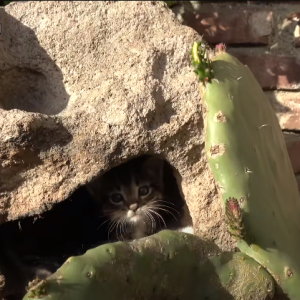Make your feline friend happy with these vet-approved strategies.
Jenna is a registered veterinary technician with a range of veterinary experience that includes small animal internal medicine, oncology, neurology, emergency, alternative medicine, and practice management.
As the Pet Health and Behavior Editor for Daily Paws, Jenna is living the dream as she combines her veterinary knowledge and passion for animals with her love of writing and education. Before Daily Paws, Jenna was a pet expert and contributor for The Spruce Pets.
When she’s not working, Jenna enjoys exploring Cincinnati with her pitty-mutt Rhyme, visiting dog-friendly breweries, and cuddling with her super kitty: RBG, AKA Ruthie.
Keeping your feline friend healthy and happy starts with a few simple steps—some of which can be integrated into your cat’s environment right away.
To help your cat live their best feline life, Los Angeles veterinarian Jeff Werber (who has eight cats himself) offers helpful advice to pet parents. “It’s crucial to get off on the right foot with cat care, ” he says. “Good daily habits are where it starts.” These tips can help you provide the love and care your cat deserves.
1. Brush Your Cat Every Day
:max_bytes(150000):strip_icc():format(webp)/brushing-cat-1251467566-2000-7577c38801e14ca58aaaf99933e05b69.jpg)
Daily brushing or combing can help reduce the number of hairballs that develop in the digestive tract and help prevent mats and tangles, especially in long-haired cats. Cats spend a lot of time grooming themselves, and pet parents may not know that they can actually help their cats by removing loose hair through regular brushing.
Werber says that the key to getting a cat to cooperate with brushing is to teach your cat to associate it with happy events. “Maybe you always brush before a meal,” he says. “Then your cat will associate it with something delicious.”
2. Don’t Feed Your Cat Too Much Dry Food
Unlike dogs, cats are obligate carnivores, meaning they rely on meat as the foundation of their diets. The main meal of the day should always be meat, says Werber. He cautions that exclusively feeding dry food diets to cats may cause them to consume too many carbohydrates, which can be unhealthy in large amounts. “We see cats developing type 2 diabetes and growing obese from too much dry food,” Werber explains.
If you have both dogs and cats, you can’t feed them the same. Dog food is not good for cats, nor can a cat metabolize carbs the way a dog can. Consider feeding wet food as a part, if not all, of your cat’s diet.
3. Pay Attention to Your Cat’s Thirst
Domestic cats evolved from desert-dwelling felines, so cats don’t naturally drink as much water as dogs. Ideally, cats should get most of their water from food. A meal that a cat might eat in the wild—such as a mouse—is about 70% water. Canned food contains about 78% water, but dry food only has 5% to 10% water on average.
It’s important to give your cat access to fresh water at all times no matter their diet, but you may notice your cat drinking more when they primarily eat dry food. Seniors, nursing cats, and cats with chronic health conditions are more prone to dehydration than others, so watch them carefully for signs such as sunken eyes, lethargy, and panting.
4. Provide a Sufficient Number of Litter Boxes
As far as potty places go, Werber says a good rule of thumb is to have one litter box per kitty, plus an additional one. So if you have three cats, you should set up four boxes, and you’ll want to think carefully about where those boxes go. Humans tend to want the boxes tucked away in a hidden spot like a basement or dark corner, but some cats are uncomfortable in these areas. Werber says to think about a cat’s natural instincts. “The animal is in a vulnerable position when performing those functions,” he says. “They want to be able to see around them.” For the same reason, your pet may not be willing to use a box with a cover or one that’s been cleverly hidden in furniture.
5. Don’t Assume You Know Why a Cat Is Peeing Outside the Box
Little frustrates a cat parent more than when kitty skips the box and pees somewhere else in the house—especially when it’s your couch or bed. Why would a cat do this? “There can be a lot of reasons,” says Werber, “and you want to rule out illness first.” Bring your cat to the vet to check for a urinary tract infection or other illness that could explain this new behavior. Once health concerns are ruled out, make sure that litter boxes meet your cat’s preferences. Experiment with different types of litter to find out if there is one type your pet prefers. Be scrupulous about keeping the box clean: scoop once or twice a day (more for multiple cats). Try changing the location of the litter box to somewhere quieter (away from noisy appliances) or easier for your cat to access.
6. Train Your Cat to Use a Scratching Post
Don’t want your new sofa ripped to shreds? Teach your cat to use a scratching post so they won’t end up clawing your furniture. The mistake many owners make, says Werber, is not knowing that they have to give the scratching post some appeal. “Put it in the center of the room to start,” he explains. If you place it in a corner far from the social action in the household, it’s easy for your cat to ignore it. Sprinkle the scratcher with catnip when you first bring it home, the vet advises. Once you have gotten your pet into the habit of using it, you can gradually move it to a less-trafficked spot and skip the catnip if desired.
7. Spay or Neuter Your Cat
There’s nothing more beneficial to your cat’s long-term wellness than getting them spayed or neutered, Werber says. “Female cats are very uncomfortable when they go into heat,” he adds. Spaying and neutering can help keep your cat safe, too. Because unaltered male cats often fight, they risk transmitting diseases through bites and scratches. The situation is not much better for female cats, either. Female cats can become pregnant as early as four months old, and mating and queening multiple litters of kittens can be very stressful. And because there are so many unwanted cats in shelters waiting for their forever homes, it’s better to not add to the population.
8. Travel Safely With Your Pet
Even if your cat wants to, don’t let them travel unrestrained in a car. It’s distracting to the driver and, in the case of an accident, a cat can become a dangerous projectile. Get a comfortable travel carrier for car rides, and teach your cat to use it without fear.
Werber also warns to “never, ever leave your cat alone in a parked car.” Even in cooler temperatures, and even with the windows cracked, a car quickly becomes uncomfortable for an animal (or human, for that matter). It takes mere minutes for a cat to perish in a warm car. Leave your cat at home if you do not plan to bring them inside with you.
9. Choose a Cat-Friendly Vet
Many veterinary practices see multiple species, including canines. This can be scary for a cat who has to sit in a waiting room surrounded by dogs. “Look for a vet who has separate waiting areas for cats and dogs,” says Werber. While that’s ideal, not all practices have the space for this. If your favorite vet doesn’t have two waiting rooms, ask to be called into the exam room quickly, Werber advises. You can also look for cat-only veterinarians in your area (yes, they exist!) so your kitty won’t get bombarded with the sights, sounds, and smells of dogs, birds, and other critters.
10. Let Them Show Off!
When a cat loves you, they like to prove it, sometimes by offering you the results of a successful hunt. Werber suggests accepting the gifts with grace (even when it’s gross—say, a decapitated mouse). Your cat may also show you love by head bunting, purring, or kneading you with their paws. Sit back and soak up the affection.
A version of this article was originally written by Clare McHugh and first appeared on Health.com.








